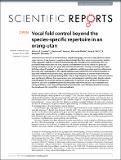Files in this item
Vocal fold control beyond the species-specific repertoire in an orang-utan
Item metadata
| dc.contributor.author | Lameira, Adriano R | |
| dc.contributor.author | Hardus, Madeleine E | |
| dc.contributor.author | Mielke, Alexander | |
| dc.contributor.author | Wich, Serge A | |
| dc.contributor.author | Shumaker, Robert W | |
| dc.date.accessioned | 2018-01-10T13:30:17Z | |
| dc.date.available | 2018-01-10T13:30:17Z | |
| dc.date.issued | 2016-07-27 | |
| dc.identifier | 252018868 | |
| dc.identifier | a41bdfc6-7b98-4095-8dbb-09cbb94e94fb | |
| dc.identifier | 84979782593 | |
| dc.identifier.citation | Lameira , A R , Hardus , M E , Mielke , A , Wich , S A & Shumaker , R W 2016 , ' Vocal fold control beyond the species-specific repertoire in an orang-utan ' , Scientific Reports , vol. 6 , 30315 . https://doi.org/10.1038/srep30315 | en |
| dc.identifier.issn | 2045-2322 | |
| dc.identifier.other | Bibtex: lameira2016vocal | |
| dc.identifier.uri | https://hdl.handle.net/10023/12451 | |
| dc.description | ARL was supported by a European Union COFUND/Durham Junior Research Fellowship. | en |
| dc.description.abstract | Vocal fold control was critical to the evolution of spoken language, much as it today allows us to learn vowel systems. It has, however, never been demonstrated directly in a non-human primate, leading to the suggestion that it evolved in the human lineage after divergence from great apes. Here, we provide the first evidence for real-time, dynamic and interactive vocal fold control in a great ape during an imitation "do-as-I-do" game with a human demonstrator. Notably, the orang-utan subject skilfully produced "wookies"-an idiosyncratic vocalization exhibiting a unique spectral profile among the orang-utan vocal repertoire. The subject instantaneously matched human-produced wookies as they were randomly modulated in pitch, adjusting his voice frequency up or down when the human demonstrator did so, readily generating distinct low vs. high frequency sub-variants. These sub-variants were significantly different from spontaneous ones (not produced in matching trials). Results indicate a latent capacity for vocal fold exercise in a great ape (i) in real-time, (ii) up and down the frequency spectrum, (iii) across a register range beyond the species-repertoire and, (iv) in a co-operative turntaking social setup. Such ancestral capacity likely provided the neuro-behavioural basis of the more fine-tuned vocal fold control that is a human hallmark. | |
| dc.format.extent | 10 | |
| dc.format.extent | 798999 | |
| dc.language.iso | eng | |
| dc.relation.ispartof | Scientific Reports | en |
| dc.subject | BF Psychology | en |
| dc.subject | QH301 Biology | en |
| dc.subject | NDAS | en |
| dc.subject.lcc | BF | en |
| dc.subject.lcc | QH301 | en |
| dc.title | Vocal fold control beyond the species-specific repertoire in an orang-utan | en |
| dc.type | Journal article | en |
| dc.contributor.institution | University of St Andrews. School of Psychology and Neuroscience | en |
| dc.identifier.doi | https://doi.org/10.1038/srep30315 | |
| dc.description.status | Peer reviewed | en |
This item appears in the following Collection(s)
Items in the St Andrews Research Repository are protected by copyright, with all rights reserved, unless otherwise indicated.

